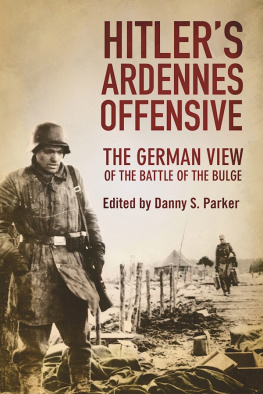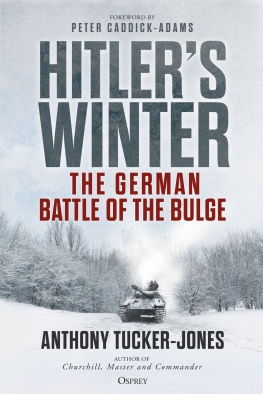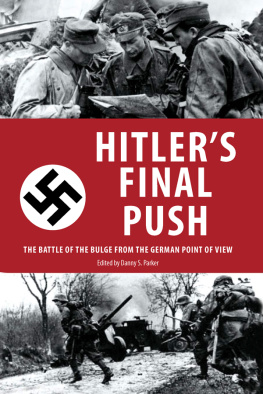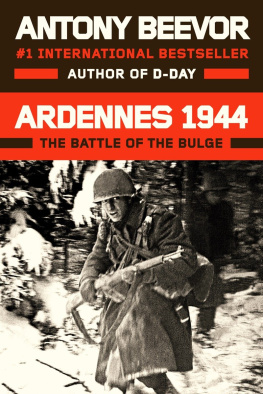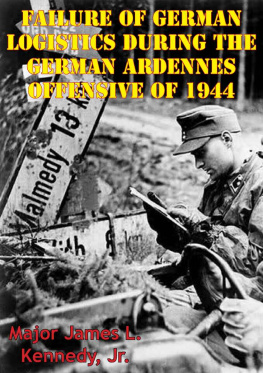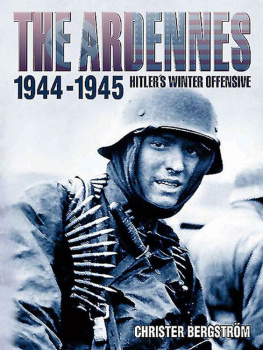Hitlers Ardennes Offensive
Also by Frontline Books
THE ANVIL OF WAR
German Generalship in Defence on the Eastern Front
BATTLE OF THE BULGE: THE GERMANVIEW
Perspectives from Hitlers High Command
FIGHTING IN NORMANDY
The German Army from DDay to VillersBocage
FIGHTING THE INVASION
The German Army at DDay
INSIDE THE AFRIKA KORPS
The Crusader Battles, 19411942
LUFTWAFFE FIGHTER FORCE
The View from the Cockpit
Hitlers Ardennes Offensive
The German View of the Battle of the Bulge
Edited by
Danny S. Parker
Hitlers Ardennes Offensive
A Greenhill Book
First published in 1997 by Greenhill Books, Lionel Leventhal Limited www.greenhillbooks.com
This edition published in 2016 by
Frontline Books
an imprint of Pen & Sword Books Ltd,
47 Church Street, Barnsley, S. Yorkshire, S70 2AS
For more information on our books, please visit
or write to us at the above address.
Preface and Introduction Danny S. Parker/Lionel Leventhal Limited, 1997 The collective work Lionel Leventhal Limited, 1997
ISBN: 978-1-84832-969-0
eISBN: 978-1-84832-971-3
Mobi ISBN: 978-1-84832-970-6
All rights reserved. No part of this publication may be reproduced, stored in or introduced into a retrieval system, or transmitted, in any form, or by any means (electronic, mechanical, photocopying, recording or otherwise) without the prior written permission of the publisher. Any person who does any unauthorized act in relation to this publication may be liable to criminal prosecution and civil claims for damages.
CIP data records for this title are available from the British Library
Publishing History
Hitlers Ardennes Offensive comprises seven U.S. Army Historical Division publications newly edited for this edition, with a Preface, Introduction and Notes: Interview with Oberstgruppenfhrer Sepp Dietrich, ETHINT 16, 1945; Interview with Oberstgruppenfhrer Sepp Dietrich, ETHINT 15, 1945; Operations of Sixth Panzer Army by Fritz Krmer, Generalmajor der Waffen SS, MS no. A-924, 1954; The Fifth Panzer Army during the Ardennes Offensive by General der Panzertruppen Hasso von Manteuffel, MS no. B-151a, 1946; Ardennes Offensive of Seventh Army by General der Panzertruppen Erich Brandenberger, MS no. A-876 volumes 1 and 2, no date; Questionnaire on the Ardennes Offensive by Generalfeldmarschall Wilhelm Keitel and Generaloberst Alfred Jodl, MS no. A-928, 1949; and The Ardennes Offensive by General der Infanterie Gnther Blumentritt, MS no. B-740, no date.
List of Illustrations and Maps
Illustrations
Josef Sepp Dietrich
Fritz Krmer, Josef Dietrich and others during the Malmdy trial in 1946
Hitler with Hermann Gring, Alfred Jodi and Wilhelm Keitel
Gerd von Rundstedt with Gnther Blumentritt
Erich Brandenberger during the campaign in Russia
Two SS grenadiers with the 1 SS Panzer Division in 1944
Hasso von Manteuffel
An armored SS reconnaissance detachment in 1944
SS panzer grenadiers at the Poteau crossroads, 1944
Maps
Operational plan for WACHT AM RHEIN
The German operational plan
Blumentritts diagram of his revised offensive
Acknowledgements
The editor wishes to express appreciation to the individuals who helped with this modest volume. At the National Archives this includes John E. Taylor and Robin E. Cookson. At the Library of Congress, Roland E. Cogan assisted with the hunt for specific portions of the John Toland Collection and Dr. Richard Sommers at the U.S. Military History Institute dealt with several last-minute questions. For special perspective on the senior commanders involved, I am further indebted to my German friends, Hans Dieter Bechtold and Ralf Tiemann. At Greenhill Books, Kate Ryle and Ian Heath accepted the challenge of deciphering the poor original typescripts with which we had to contend no small task.
The photographs in the book are all attributed to the U.S. Army Signal Corps photographers from the period. The exceptions are the photographs of Generals Brandenberger and Blumentritt which are courtesy of Michael Wenger and his personal archives. Many thanks to all.
Danny Parker, 1997
The German operational plan
Preface
BY D ANNY S. P ARKER
Immediately after the cessation of hostilities in Europe following the Second World War, U.S. Army military historians seized upon a fleeting opportunity. As victors, they had the ability to interview prominent enemy commanders being then held prisoner in various locations within Germany. The European Theater of Operations (ETO) Historical Section saw this as a remarkable opportunity to provide historical data of great importance for future documentation of the great conflict. The project was first initiated by Colonel William A. Ganoe, but the use of interviews with German participants in the Ardennes operations was begun by Colonel S.L.A. Marshall and Captain Kenneth W. Hechler. Colonel Harold Potter turned the operation into a fully-fledged program with the assistance of a group of able young officers. During 19459, this was performed with great enthusiasm and dozens of interviews and written accounts were composed on a variety of campaigns. However, no conflict elicited as much in the way of interviews, commentary and analysis as the Ardennes Offensive known to the Allies as the Battle of the Bulge.
The reason for this interest in the Ardennes was simple: in no other campaign had the enemy so dramatically embarrassed the Allies with their cunning and sheer ferocity as in this final great desperate gamble in December of 1944. Some confident American G-2s went from predicting impending collapse of the German war machine to pondering whether the enemy might somehow have developed some new weapon of unprecedented destructive power. Top secret espionage missions were again repeated to ensure that no further German progress had been made in the area of atomic research. Of course, all of this was untrue, but after the war the Allies were understandably curious about the nature of the German attack. Much of the collected data was instrumental in providing information for the U.S. Army green books the official histories of the various campaigns. Until now, however, this material has largely been available only to military historians with a budget to see or reproduce the source documents. I have always seen this as unfortunate, given the insightful quality of many of the manuscripts which I have had occasion to review over the years. Since many of these were composed by the German commanders without access to their official records, or maps, there are inevitable errors associated with memory. Yet this series of manuscripts, composed so soon after the end of the war, provides a compelling snapshot of the German view of the Battle of the Bulge.







